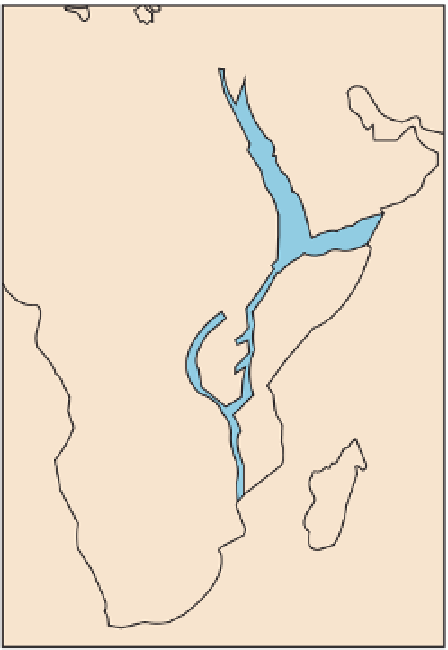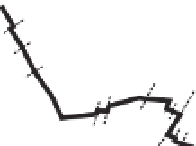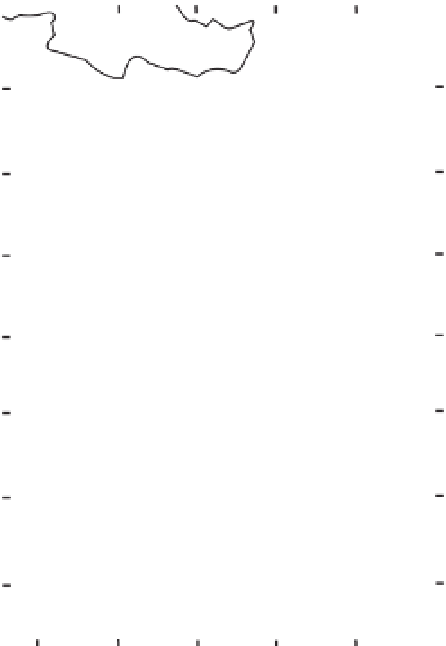Geology Reference
In-Depth Information
of satellite images of surface features
before and after a large seismic rifting
event in 2005 in the Afar triple junc-
tion revealed a horizontal displace-
ment of 6 m associated with faulting,
dyke intrusion and volcanic eruption.
The third arm of the system, the
African rift, is divided into two branches
- the western and eastern rifts. Here the
tectonic history is well documented: an
initial doming of the surface was fol-
lowed by collapse of the rifts accompa-
nied by extensive vulcanicity, but there
has been no significant separation.
crustal stretching
A
ocean floor
basalt lavas
basalt dykes
crust
gabbro
intrusions
~6km
magma
chamber
ultrabasi c
residue
top of
upper
mantle
mantle
peridotite
partly melted
mantle peridotite
B
Figure 3.9
Constructive boundaries.
A.
Ocean ridges: creation of new oceanic
crust at an ocean ridge. Partly melted
hot mantle peridotite rises into the crust
to form a magma chamber within the
oceanic crust, aided by the stretching
of the crust. The magma then separates
into an ultrabasic residue, which sinks
to the base of the chamber, and a basalt
liquid, part of which solidifies within
the crust as gabbro intrusions, and
part moves up to the surface to form
basalt lavas through narrow fissures that
become dykes, forming the sheeted
dykes layer. As new hot mantle material
continues to rise, the newly formed
crust and mantle moves to the side and
slowly cools to form normal oceanic
lithosphere. Based on Bott (1982).
B.
Continental rifts - the Red Sea-Gulf of
Aden-African rift system: new oceanic
crust is being formed along the Red Sea
and Gulf of Aden rifts to join up with
the West Indian Ocean ridge, causing
the Arabian plate to break away from
the African plate. No separation has yet
occurred along the African rift, although
considerable volcanic activity has
occurred here over the last 40 Ma or so.
Based on Girdler & Darricott (1972).
20E
40E
Dead Sea
transform
fault
Plate destruction
There are two types of destructive plate
boundary (Figure 3.10). The first type
follows a zone of destruction of oceanic
lithosphere and is marked at the present
day by the deep-ocean trenches; the
second type is a zone of collision of two
continental plates, and is exemplified
at present by the Alpine-Himalayan
belt of young mountain ranges. This
second type of boundary is, in geologi-
cal terms, only temporary, since con-
vergent movement will eventually cease
as the two continental plates grind
together and gradually come to a halt.
ARABIAN
PLATE
Red
Sea
Rift
20N
20N
Gulf of Aden
Rift
AFRICAN PLATE
African Rift
Somalia
sub-plate
West Indian
Ocean ridge
Eastern
Rift
0
Western
Rift
LV
African Rift
20S
20S
Subduction
The standard case of the destructive
boundary, therefore, is where oceanic
lithosphere on one plate (the lower)
descends beneath another plate (the
upper), which may be either continental
or oceanic. The line of descent is marked
at the surface by a deep-ocean trench
and is known as a
subduction zone
; this
zone is typically inclined beneath the
upper plate, and its position at depth
is indicated by the line of deep earth-
quakes that follow the inclined plate
20E
40E
Aden - new oceanic crust has formed
along the centre of the rifts and joins
up with the western Indian Ocean
ridge. The separate Arabian plate thus
formed is moving north-eastwards
away from Africa. Both these rifts
are destined eventually to become
oceans as Arabia and Africa move
apart. In this way the continents of the
Americas, Europe and Africa would
have separated during the split-up of
Pangaea (
see
Figure 3.2). A comparison



















































Search WWH ::

Custom Search